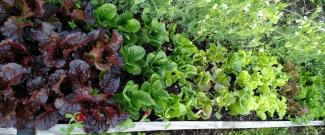
Portfolio Recommendations from my Italian Vegetable Garden
Harvesting (Selling) High and Planting (Buying) Low
I spent quite a bit of time weeding and managing my vegetable garden this weekend. While fertilizing and watering my tomatoes and peppers, I caught numerous fragrant whiffs of my Genovese basil, telling me in no uncertain terms that summer has arrived. While some of my basil will be used in making spaghetti sauce (a/k/a gravy here in Philadelphia) and Caprese salad (fresh mozzarella, garden tomatoes, balsamic, and olive oil), most of it will be ground with pine nuts, garlic, and olive oil and frozen as pesto to be enjoyed throughout the Fall and Winter.
Basil is one of those tender plants that need to be managed and pruned. Left to its own, basil will grow straight up, produce small flower blossoms, and subsequently become bitter and unappetizing. However, if basil’s vertical growth is pinched (pruned/harvested) regularly, the blossoms never flower, and the plant will send out side shoots producing more even leaves. As I thought about what I needed to do to manage my basil, I came to the realization that what I do in my garden is not dissimilar to the portfolio rebalancing that I do in my day job.
Retirement portfolios need to be rebalanced when one area grows (or declines) at a different rate than the others. For example, a portfolio of 50% stocks, 30% bonds, and 20% real estate might be appropriate for a specific couple, but the stock percentage might rise to 60% or so in a bull market. Although it sounds counter-intuitive, this situation calls for us to “rebalance” and sell some of those “winners” (stocks) and buy bonds and/or real estate to re-establish the 50%/30%/20% allocation. Otherwise, the overexposure to the appreciated stocks would subject the entire portfolio to significant losses if a market correction similar to 2000 or 2008/2009 subsequently occurs. Pruning that appreciation locks in the winnings and takes your gains “off the table.”
Thinking it through, my entire garden is a portfolio of vegetables and herbs. If any single vegetable grows straight up and is not managed, it will likely fall over (tomato plants) or flower and go up in seed and stop growing (like herbs and lettuce). The output potential of the entire garden is maximized if each plant is managed and pruned back before it gets so big that it falters under its own weight.
Managing a garden and making (and eating) pesto is much more fun than balancing portfolios, and I haven’t even begun to discuss wine pairing suggestions. The bottom line here is that stocks have been in an 9-year bull market, and if you haven’t rebalanced your portfolio, you may be subjecting yourself to significant losses if a correction occurs. So check your allocation to see if your portfolio is in balance, and if it is not, harvest some of those gains and reinvest. Otherwise, you may find yourself with a bitter taste in your mouth after the next correction.

